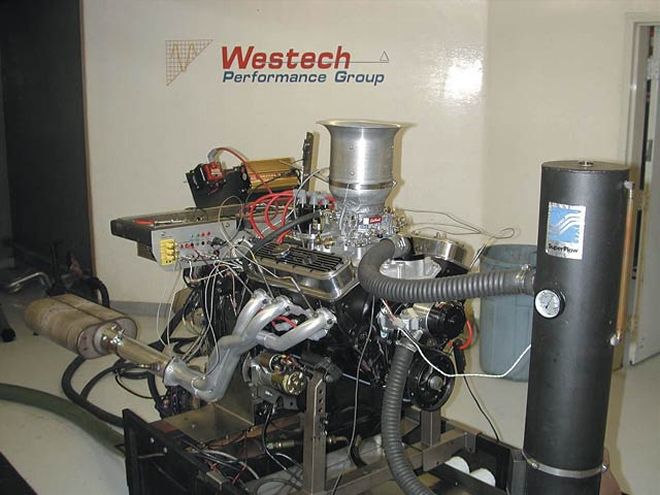
| 132 0110 Powr00 Z
One of the pitfalls to owning and driving a truck is that some day it will wear out. Even the best built and engineered truck will give out. For obvious reasons, engines are usually the last big thing to blow before the truck is parked for the big sleep. The decision is what to do with it.
Any rebuild will breathe new life into a truck, but there are limiting factors for the everyday driver. Spending money is a hard pill to swallow knowing that the thing still has to pass emissions and probably cannot be internally juiced up. Not anymore! Competition Cams has the perfect package for any V-6 rebuild that gives an extra 42 ponies and maintains emissions to a "T."
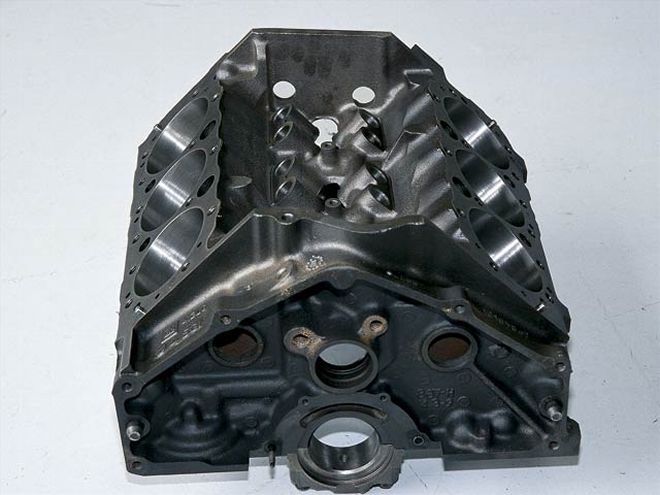
| Westech had the stock 4.3L block bored 0.030 over. A qualified machinist or mechanic should closely examine any rebuild block to check for cracks and irregularities in the metal.
The modern Chevrolet 4.3L V-6 is an electronically-injected and computer-controlled powerplant. The computers in these little guys have a myriad of sensors throughout the engine system that allow operational variances to be detected and adjusted. The idea is that, based on several sensor readings, the computer adjusts the fuel curve to accommodate the power load on the engine and do it efficiently. However, a major factor in a performance engine's ability to produce power is the camshaft. It just so happens that high-power engines with big lumpy cams don't produce a great amount of vacuum, which is what the sensors read in order for the computer to calibrate a fuel curve. With any rebuild, the cam has to be replaced, so why not juice that S-10 a wee bit in the process?
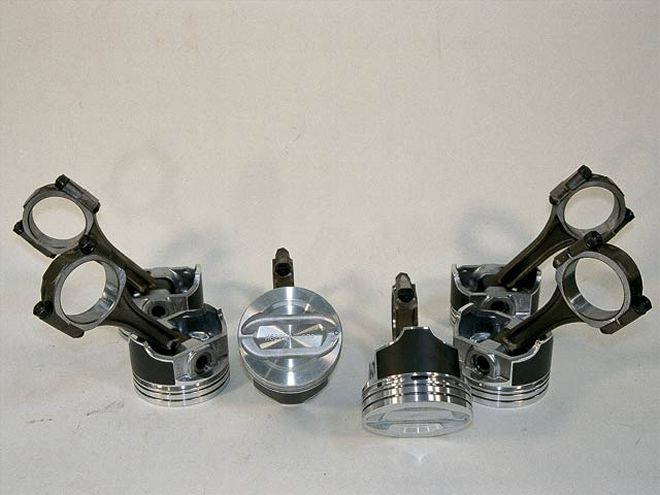
| Speedpro pistons feature an anodized section around the piston skirt. This encourages better cylinder wall lubrication as oil adheres to the anodized portion and is promoted further up the cylinder wall with every stroke.
Westech Performance of Mira Loma, California, let us follow along with the mother of all V-6 rebuilds. The goal is to achieve maximum power while maintaining necessary manifold vacuum in order for the engine computer to function properly.
Although the engine is designed to be run by the ECM (engine control module) and fuel injection, the first part of this test has to be done with carburetion due to the necessary setup of the engine dyno. In part two, we'll hook up the ECM in the truck and run a chassis dyno to give you a more complete picture of your options in a 4.3L package.
Westech started out with stock heads and engine freshly bored 0.030 over. Before rebuilding the engine it's important that it be bore-gauged and thoroughly checked for cracks in the metal. A straight block and heads for the rebuild should yield an engine that will last just as long for its second cycle as the first. Rebuilding the engine to a stock configuration doesn't necessarily mean using genuine GM parts. Cost versus quality is a factor for everyone in selecting parts, but keep in mind you get what you pay for. With that said, onto the buildup.
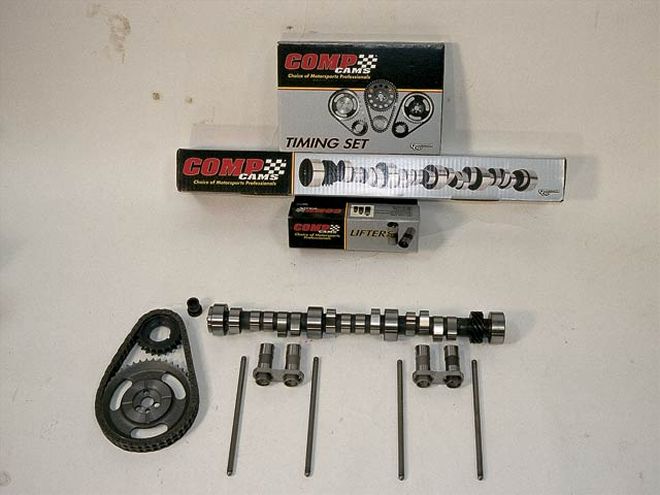
| The only difference from stock configuration in Westech's rebuild was the cam. You can order just the cam from Competition Cams, or a K-kit, which comes with every component needed for the cam switch.
Westech inserted Speedpro pistons for a 0.030 overbore with stock connecting rods and selected sealed power piston rings to wrap them in. Sealed power journal bearings were used for the crank as well as cam. Speedpro OEM valves were installed in the head along with Competition Cams double valvesprings. Next came the Competition Cams camshaft. Keep in mind the cam cannot be too radical or else the stock computer won't function properly. The selected cam has 110 degrees lobe separation, 252 advertised duration, and 206 duration at 0.050. The cam should level out the torque curve, which will give stout performance all around and be great for towing. In combination with the cam, Westech used Comp Cams roller rockers, roller lifters, pushrods, locks, retainers, and double-lap timing chain. For compatibility with the engine dynamometer, an Edelbrock low-rise manifold with spacer was slapped on with a Demon carburetor atop. The power from a properly tuned carburetor setup should be a hair away from different to that of injection.
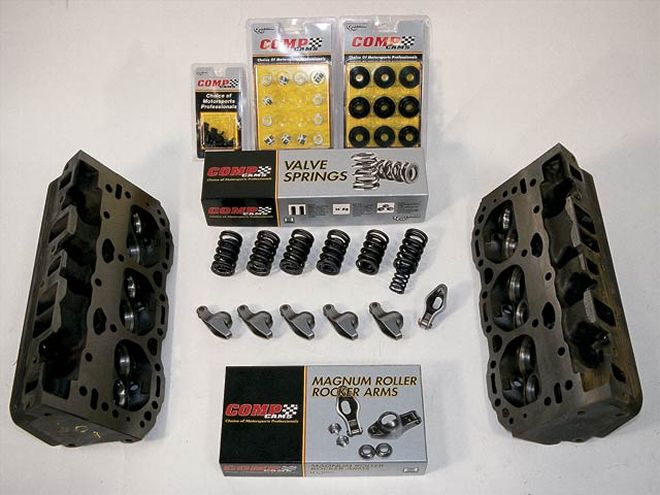
| In addition to machining the block, Westech had the heads fully checked out and valves reworked.
With the engine assembled, Westech slapped it on the Dyno to see some numbers. After a few carburetor jet changes and timing tweaks the engine was idling smoothly and produced 222 hp at 4,800 rpm. The stock V-6 pumps out only 180 hp at that rpm and the only true difference in engine configuration is the cam. Another area of improvement was the torque production. With the new cam, torque peaked at 275.2 lb-ft at 2,500 rpm and didn't drop below 250 lb-ft until 4,650 rpm. What that translates into is a good amount of torque over a wide engine operating range giving more towing capability and low-end performance from the engine.
Recipe Card•4.3L Vortec block bored 0.030 over
•Stock Vortec iron heads
•Stock crank and rods
•Stock oil pan, sump, and pump
•Competition Cams: Camshaft PN 18-119-4 (high-energy flat tappet)Lifters PN 812-12 , Timing chain set PN 3200,Rocker arms PN 1412-12, Push rods PN 7812-12, Valvesprings PN 980-12, 1-inch carb spacer
•Edelbrock Performer intake PN 2111
•Demon 625-cfm Road Demon Carb w/No. 65 Primary jets, stock secondaries
•MSD PN 8597 Distributor, total timing advance = 34 degrees
•Peak horsepower: 222 @ 4,800 rpm
•Peak torque: 275.2 @ 2,500 rpm
 | 132 0110 Powr00 Z
One of the pitfalls to owning and driving a truck is that some day it will wear out. Even the best built and engineered truck will give out. For obvious reasons, engines are usually the last big thing to blow before the truck is parked for the big sleep. The decision is what to do with it.
Any rebuild will breathe new life into a truck, but there are limiting factors for the everyday driver. Spending money is a hard pill to swallow knowing that the thing still has to pass emissions and probably cannot be internally juiced up. Not anymore! Competition Cams has the perfect package for any V-6 rebuild that gives an extra 42 ponies and maintains emissions to a "T."
| 132 0110 Powr00 Z
One of the pitfalls to owning and driving a truck is that some day it will wear out. Even the best built and engineered truck will give out. For obvious reasons, engines are usually the last big thing to blow before the truck is parked for the big sleep. The decision is what to do with it.
Any rebuild will breathe new life into a truck, but there are limiting factors for the everyday driver. Spending money is a hard pill to swallow knowing that the thing still has to pass emissions and probably cannot be internally juiced up. Not anymore! Competition Cams has the perfect package for any V-6 rebuild that gives an extra 42 ponies and maintains emissions to a "T."
 | Westech had the stock 4.3L block bored 0.030 over. A qualified machinist or mechanic should closely examine any rebuild block to check for cracks and irregularities in the metal.
The modern Chevrolet 4.3L V-6 is an electronically-injected and computer-controlled powerplant. The computers in these little guys have a myriad of sensors throughout the engine system that allow operational variances to be detected and adjusted. The idea is that, based on several sensor readings, the computer adjusts the fuel curve to accommodate the power load on the engine and do it efficiently. However, a major factor in a performance engine's ability to produce power is the camshaft. It just so happens that high-power engines with big lumpy cams don't produce a great amount of vacuum, which is what the sensors read in order for the computer to calibrate a fuel curve. With any rebuild, the cam has to be replaced, so why not juice that S-10 a wee bit in the process?
| Westech had the stock 4.3L block bored 0.030 over. A qualified machinist or mechanic should closely examine any rebuild block to check for cracks and irregularities in the metal.
The modern Chevrolet 4.3L V-6 is an electronically-injected and computer-controlled powerplant. The computers in these little guys have a myriad of sensors throughout the engine system that allow operational variances to be detected and adjusted. The idea is that, based on several sensor readings, the computer adjusts the fuel curve to accommodate the power load on the engine and do it efficiently. However, a major factor in a performance engine's ability to produce power is the camshaft. It just so happens that high-power engines with big lumpy cams don't produce a great amount of vacuum, which is what the sensors read in order for the computer to calibrate a fuel curve. With any rebuild, the cam has to be replaced, so why not juice that S-10 a wee bit in the process?
 | Speedpro pistons feature an anodized section around the piston skirt. This encourages better cylinder wall lubrication as oil adheres to the anodized portion and is promoted further up the cylinder wall with every stroke.
Westech Performance of Mira Loma, California, let us follow along with the mother of all V-6 rebuilds. The goal is to achieve maximum power while maintaining necessary manifold vacuum in order for the engine computer to function properly.
Although the engine is designed to be run by the ECM (engine control module) and fuel injection, the first part of this test has to be done with carburetion due to the necessary setup of the engine dyno. In part two, we'll hook up the ECM in the truck and run a chassis dyno to give you a more complete picture of your options in a 4.3L package.
Westech started out with stock heads and engine freshly bored 0.030 over. Before rebuilding the engine it's important that it be bore-gauged and thoroughly checked for cracks in the metal. A straight block and heads for the rebuild should yield an engine that will last just as long for its second cycle as the first. Rebuilding the engine to a stock configuration doesn't necessarily mean using genuine GM parts. Cost versus quality is a factor for everyone in selecting parts, but keep in mind you get what you pay for. With that said, onto the buildup.
| Speedpro pistons feature an anodized section around the piston skirt. This encourages better cylinder wall lubrication as oil adheres to the anodized portion and is promoted further up the cylinder wall with every stroke.
Westech Performance of Mira Loma, California, let us follow along with the mother of all V-6 rebuilds. The goal is to achieve maximum power while maintaining necessary manifold vacuum in order for the engine computer to function properly.
Although the engine is designed to be run by the ECM (engine control module) and fuel injection, the first part of this test has to be done with carburetion due to the necessary setup of the engine dyno. In part two, we'll hook up the ECM in the truck and run a chassis dyno to give you a more complete picture of your options in a 4.3L package.
Westech started out with stock heads and engine freshly bored 0.030 over. Before rebuilding the engine it's important that it be bore-gauged and thoroughly checked for cracks in the metal. A straight block and heads for the rebuild should yield an engine that will last just as long for its second cycle as the first. Rebuilding the engine to a stock configuration doesn't necessarily mean using genuine GM parts. Cost versus quality is a factor for everyone in selecting parts, but keep in mind you get what you pay for. With that said, onto the buildup.
 | The only difference from stock configuration in Westech's rebuild was the cam. You can order just the cam from Competition Cams, or a K-kit, which comes with every component needed for the cam switch.
Westech inserted Speedpro pistons for a 0.030 overbore with stock connecting rods and selected sealed power piston rings to wrap them in. Sealed power journal bearings were used for the crank as well as cam. Speedpro OEM valves were installed in the head along with Competition Cams double valvesprings. Next came the Competition Cams camshaft. Keep in mind the cam cannot be too radical or else the stock computer won't function properly. The selected cam has 110 degrees lobe separation, 252 advertised duration, and 206 duration at 0.050. The cam should level out the torque curve, which will give stout performance all around and be great for towing. In combination with the cam, Westech used Comp Cams roller rockers, roller lifters, pushrods, locks, retainers, and double-lap timing chain. For compatibility with the engine dynamometer, an Edelbrock low-rise manifold with spacer was slapped on with a Demon carburetor atop. The power from a properly tuned carburetor setup should be a hair away from different to that of injection.
| The only difference from stock configuration in Westech's rebuild was the cam. You can order just the cam from Competition Cams, or a K-kit, which comes with every component needed for the cam switch.
Westech inserted Speedpro pistons for a 0.030 overbore with stock connecting rods and selected sealed power piston rings to wrap them in. Sealed power journal bearings were used for the crank as well as cam. Speedpro OEM valves were installed in the head along with Competition Cams double valvesprings. Next came the Competition Cams camshaft. Keep in mind the cam cannot be too radical or else the stock computer won't function properly. The selected cam has 110 degrees lobe separation, 252 advertised duration, and 206 duration at 0.050. The cam should level out the torque curve, which will give stout performance all around and be great for towing. In combination with the cam, Westech used Comp Cams roller rockers, roller lifters, pushrods, locks, retainers, and double-lap timing chain. For compatibility with the engine dynamometer, an Edelbrock low-rise manifold with spacer was slapped on with a Demon carburetor atop. The power from a properly tuned carburetor setup should be a hair away from different to that of injection.
 | In addition to machining the block, Westech had the heads fully checked out and valves reworked.
With the engine assembled, Westech slapped it on the Dyno to see some numbers. After a few carburetor jet changes and timing tweaks the engine was idling smoothly and produced 222 hp at 4,800 rpm. The stock V-6 pumps out only 180 hp at that rpm and the only true difference in engine configuration is the cam. Another area of improvement was the torque production. With the new cam, torque peaked at 275.2 lb-ft at 2,500 rpm and didn't drop below 250 lb-ft until 4,650 rpm. What that translates into is a good amount of torque over a wide engine operating range giving more towing capability and low-end performance from the engine.
Recipe Card
| In addition to machining the block, Westech had the heads fully checked out and valves reworked.
With the engine assembled, Westech slapped it on the Dyno to see some numbers. After a few carburetor jet changes and timing tweaks the engine was idling smoothly and produced 222 hp at 4,800 rpm. The stock V-6 pumps out only 180 hp at that rpm and the only true difference in engine configuration is the cam. Another area of improvement was the torque production. With the new cam, torque peaked at 275.2 lb-ft at 2,500 rpm and didn't drop below 250 lb-ft until 4,650 rpm. What that translates into is a good amount of torque over a wide engine operating range giving more towing capability and low-end performance from the engine.
Recipe Card